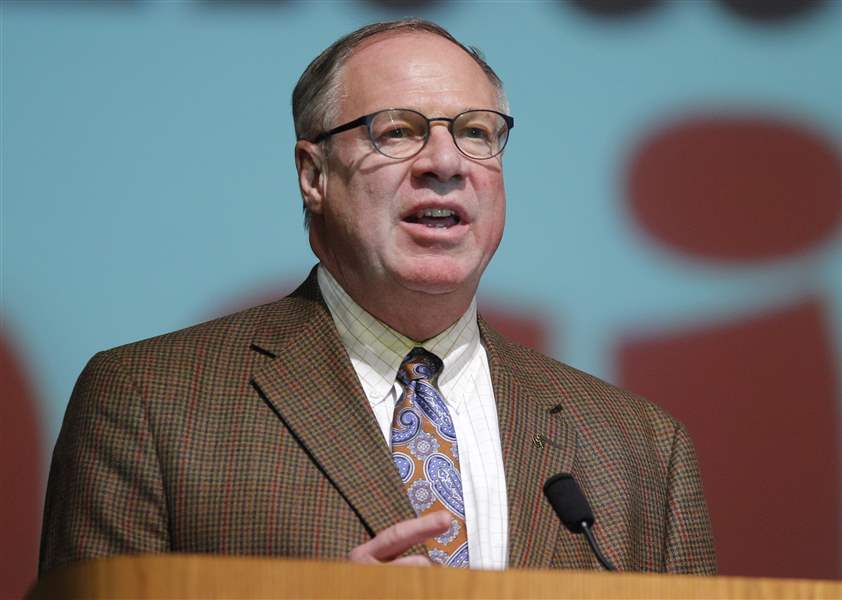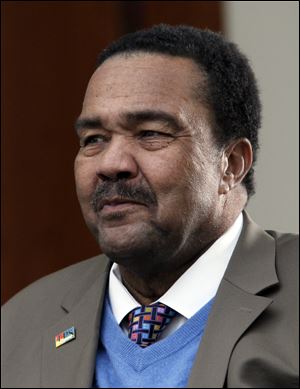
Housing missteps draw concerns
City officials urge better use of federal funds
2/20/2014
Andy Morrison

Ford
The city of Toledo should be a better steward of federal tax dollars used for home-building and also prevent the multitude of past missteps that led to publicly subsidized housing deteriorating to the point that many are now being razed, several councilmen and Mayor D. Michael Collins concluded Wednesday during a lengthy public hearing.
Councilman Jack Ford, chairman of council’s neighborhoods committee, asked for updates on several controversial housing projects for the hearing.
Mr. Ford said federal money was treated like “Monopoly money” with projects like the Dorr Street Brownstones and homes built by the now-defunct community development group Organized Neighbors Yielding eXcellence, which was also called ONYX.
“We’ve really missed the point for some years with using federal dollars and this is another example,” Mr. Ford said, referring to the six-condominium project built on Dorr Street by a private developer.
Only one unit sold after several years and the building was sold to the Lucas Metropolitan Housing Authority in 2012.
LMHA Executive Director Linnie Willis said the project cost about $900,000, which includes $526,975 of federal funding. The units were originally listed at about $105,000 each but have since been reduced to $79,000 and $69,000.
Mr. Ford said it didn’t make sense to spend $900,000 with the anticipation that only $600,000 could be recouped with the sales.
Councilman Rob Ludeman said the project seemed “doomed from the start” because of the price, location, and design of the condominiums.
Ms. Willis said LMHA could attempt to rent the units if they cannot be sold.
Similar criticisms were levied against homes built by ONYX.
Last year, Lucas County officials filed foreclosure proceedings over thousands of dollars owed in back taxes for more than 80 homes built by the group with federal money between 1997 and 1999.
The houses were highlighted in a Blade investigation that found many of the homes had since been boarded up. The houses were built as part of a federal tax-credit program in which local developers can sell tax credits to investors to raise funds for acquisition, rehabilitation, and construction.
The Blade found vacant tax-credit properties blighting several city neighborhoods — boarded up, stripped of plumbing and wiring, or otherwise gutted or burned out. Mr. Ford said many of the homes were “sloppily done.”
Those homes cost about $120,000 to build and were going to be sold for $30,000, said Lucas County Land Bank President David Mann.
“Any project, especially in our core neighborhoods, you are going to be looking at public subsidies,” Mr. Mann said.
Last year, it was announced that Toledo’s Olde Towne neighborhood — blighted in some areas with abandoned homes and unkempt vacant lots — would have 40 new single-family homes constructed over the following eight months. Then-Mayor Mike Bell, Mercy St. Vincent Medical Center, and nonprofit organizations announced the $10.4 million project that is to be completed by April.
The $10.4 million in funding includes $8.8 million from private equity, $750,000 from federal HOME funds through the city of Toledo, and $300,000 from NeighborWorks Toledo Region. The project also involves a $1 million loan from the Ohio Housing Finance Agency and a $7.7 million loan from Key Bank.
At that amount, each home costs $260,000 to build. Income-restricted renters will be able to purchase the homes after 15 years.
Mr. Ford and Mayor Collins said Wednesday that the city, which allocates federal money, needs to scrutinize developments.
“You can’t justify to me how you have a plan to build for $120,000 and sell for $60,000, let alone $30,000,” Mr. Ford said.
Mayor Collins said blame falls to everyone.
“There is enough guilt to go around,” he told the committee. “The [community development corporations] ran amok; didn’t manage the properties right,” he said. “These mistakes were preventable … but no one had the political will to say no.”
A decade ago, the city had 14 community development agencies. Some have been forced to close or merge with others to reduce costs and share resources. Mr. Ford, when he was mayor, led the charge during his one term in office to reduce the number of community development corporations in the city.
ONYX was the most notable failure. It shut down early during the Bell administration and was sued by the city in 2012 over repayment of a note. Despite troubles with the organization, the city’s 2008-09 action plan on how to spend its federal Community Development Block Grant Funding included funding for ONYX. Mayor Collins, who was then on council, voted against that allocation.
Tom Kroma, the city’s neighborhoods director, said it is “unfortunate” that so many federally funded homes fell into disrepair.
“We are going to take an active role in all housing projects,” Mr. Kroma said.
Contact Ignazio Messina at: imessina@theblade.com or 419-724-6171 or on Twitter @IgnazioMessina.